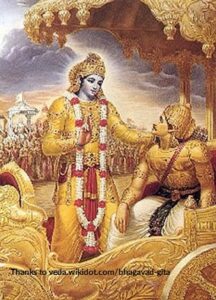Post By:
Vishwanath Iyer
Published on: December 25, 2022
Reading time: 7 minutes
How do the ancient seers (ṛṣi) explain karma?
There have been many references on why people perform action. Most people perform action for an outcome. Outcome is generally motivated by desire which is quantifiable, objective or visible (dṛṣṭaphala) or for an outcome that is not visible or quantifiable (adṛṣṭaphala).
Examples of visible karma (dṛṣṭaphala) or karma with visible outcomes – we study and get the results that are commensurate with our efforts. Similarly, when we buy something, we get direct inputs on the quality of the item that we have bought.
Examples of invisible karma (adṛṣṭaphala) or karma that occurs without our cognition – our heart beats, out stomach churns and blood circulates, yet, we do not cognise it. We speak with someone, we can only gauge how much they have understood. We use cars without cognising the impact on climate change. Similarly, we tavel without tickets or cheat on our taxes without fully cognising the impact on our country.
Charity (dāna) is both dṛṣṭa and adṛṣṭaphala. Charity where we are directly involved like feeding the poor anna-dāna , is dṛṣṭaphala but just giving money (lakshmi-dāna) is adṛṣṭaphala because one is never sure how the money will be used. So, since we control the outcome, dṛṣṭaphala is always better than adṛṣṭaphala.
Importantly, since our cognition is limited by our awareness, most karma is adṛṣṭaphala. This is why Śrī Kṛṣṇa tells Arjuna in Śrīmad-Bhagavad-Gītā that the current of karma runs deep.
Chapter 4 – Also, should be known of action, as should be known prohibited action and knowledge of inaction, because action is deep (karmaṇo hyapi boddhavyaṃ boddhavyaṃ ca vikarmaṇaḥ । akarmaṇaśca boddhavyaṃ gahanā karmaṇo gatiḥ ॥ 4-17॥). He who perceives action in inaction and inaction in action is wise among men and in complete union in all action (karmaṇyakarma yaḥ paśyedakarmaṇi ca karma yaḥ । sa buddhimānmanuṣyeṣu sa yuktaḥ kṛtsnakarmakṛt ॥ 4-18॥).
Karma according to Jaimini’s pūrva-mīmāṃsā (early reflections).
- Jaimini’s pūrva-mīmāṃsā is one of the earlies attempts to classify how life should be lived. It was written around 300-200 BCE.
- Jaimini states that all actions (karma) should be performed as a sacrifice (yajñá).
The classification of karma is as follows;
- Nitya-karma (perpetual, mandatory or daily sacrifices) – covers the five major sacrifices (panca-maha-yajñás) that any individual is supposed to perform. These five (panca-maha-yajñá) are – rishi-yajñá (sacrifice to the seers), deva-yajñá (sacrifice to the deities, represented by the vedas) and pitṛ-yajñá (sacrifice to the manes) which are covered in a ritual called brahma-yajñá. Bhūta-yajñá, which covers supporting all sentient and insentient creations and finally mānuṣyaka-yajñá which covers helping other less fortunate human beings. Nitya-karma also covers regular rituals such as sandhya-vandana (salutation to the various transitions of the Sun), tarpaṇa and śrāddha (ceremonies to feed the manes) as well as other prescribed rituals.
Importantly, nitya-karma is a hygiene factor. Doing it will not add value, but not doing it will create debt.
- Naimittika-karma (periodic or optional karma) – covers sacrifices that are performed to support various rites-of-passage (samskāra) such as naming ceremony, marriage ceremony, death ceremony etc. Naimittika-karma also covers upanayana-samskāra which is performed whenever there is knowledge transmission. Also, naimittika-karma is generally performed with a selfish objective that does not harm anyone. Consequently, it creates debt.
- Kāmya-karma (karma motivated by desire) – covers optional sacrifices and refers to any sacrifice performed with a desire for material gain. This karma creates more debt than naimittika-karma because there will be winners and losers.
- Niṣāda-karma (forbidden action) – covers any action that goes against order and harmony (dharma). This is also called vikarma in Srimad-Bhagavad-Geeta, chapter 4. Obviously, this karma is to be avoided.
- It is important to note that both nitya and naimittika-karma obligatory and must be performed at prescribed. These sacrifices do not yield any fruits, they are mandatory maintenance actions for maintaining personal dharma (svadharma). Failure to do so will result in debt (ṛṇānubandha).
- Both kamya-karma and niṣāda-karma will result in debt depending on the severity of impact of the action.
Karma according to Śrī Kṛṣṇa in Śrīmad-Bhagavad-Gītā.

Śrī Kṛṣṇa classifies action into three types, action (karma), inaction (akarma) and forbidden action (vikarma) in Chapter 4. Importantly, Śrī Kṛṣṇa states that even inaction is action and only action which is performed as a sacrifice (yajñá) is karma that will not result in debt (ṛṇa).
- First, sacrifice where action that is performed without desire (niṣkāmya-karma). Here, action and result are experienced without duality such as like-dislike, good-bad or right-wrong.
- Next, sacrifice also occurs when one renounces the fruit of one’s action (karmaphala-tyāga), which means that the person becomes indifferent to success or failure of the result.
- Lastly, sacrifice occurs when the person is in a state of renunciation when acting (karma-saṃnyāsa).
What this means is that when a person removes individuality or sense of doership from the action, there is no karma or generation of debt.
How does karma impact rebirth?
As mentioned above, all actions (karma) result in an outcome. Some we like, others we dislike. This like-dislike / give-take dichotomy drives us to identifying the outcome with the person. Consequently, we pull the person closer or push the person away. Also, this transaction is never equal. in fact, we either give or get more. As a result, there is a generation of debt by us or towards us.
Consequently, the debt, like all debt, has to be paid off, there is no free lunch. So, if karma generated in this birth is not paid off in this life, then there comes a need for another birth to pay the debt off. This is the basis of the concept of rebirth (saṃsāra).
How can we avoid rebirth?
Thanks to Śrī Ron Wells for asking the question.
- Karma, by itself, is inert. It doesn’t care who does what.
- Next, debt is generated when value is ascribed to the effort as well as entity in the transaction.
- Since there is a disparity in give and take, and one of the entities gives or gets more, there is a creditor or debtor in the transaction.
- This debit and credit needs to be reconciled, if not in this birth, then in the next.
- Importantly, this bond exists for as long as the debt exists. Thereafter, the bond between the entities will dissolve.
- Also, this debt is carried by the sense of Identity (puruṣa). So, the debt exists as long as the sense of identity exists. This means that if the person were to negate his or her sense of Identity, then karma will cease to get created because there is no one to credit or debit it to. For example, our debt to the bank exists only for as long as we are alive. Thereafter, there is neither debit nor credit.
So, how can we stop the identity (puruṣa) from creating karma? Through the practice of Yoga. When we practice yoga, the consciousness slowly stops seeking validation, becomes steady within the Self and finally stops moving. The state when it stops moving is called samādhi. In this state, even though action may be happening, there is no generation of debt because there is no creation or destruction of value.
Some points to ponder on karma.
Internal Tags: Self Awareness or Asmita, Karma Yoga (Bhagawat Gita – chapter 3)
External Tags: vāsanā (karmic image), pūrva-mīmāṃsā, nitya-karma, brahma-yajñá,
- How do situations impact karma?
- Can a hurtful word impact karma?
- How does obsession impact karma?


